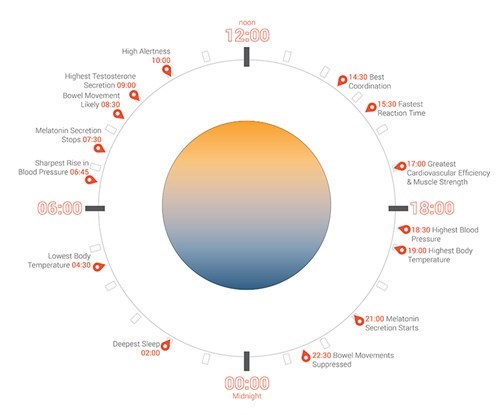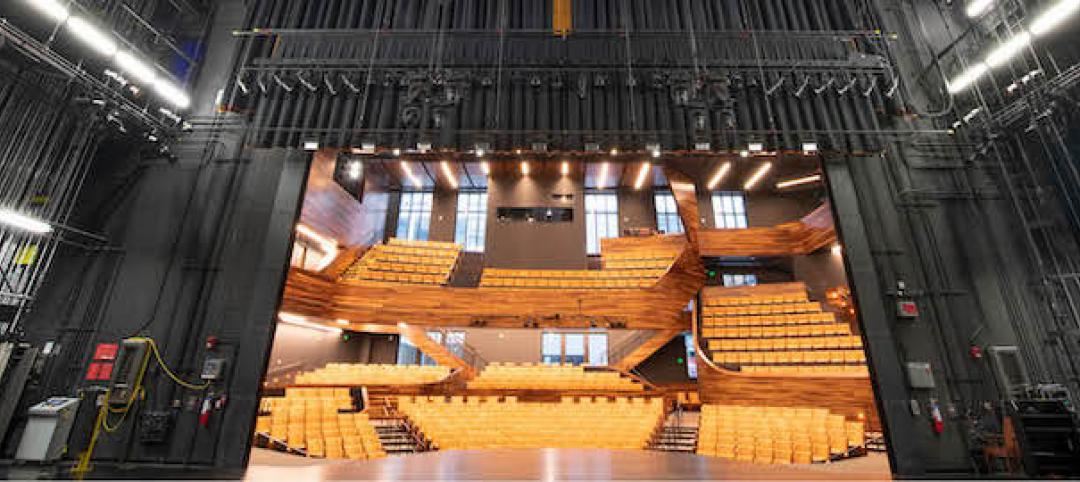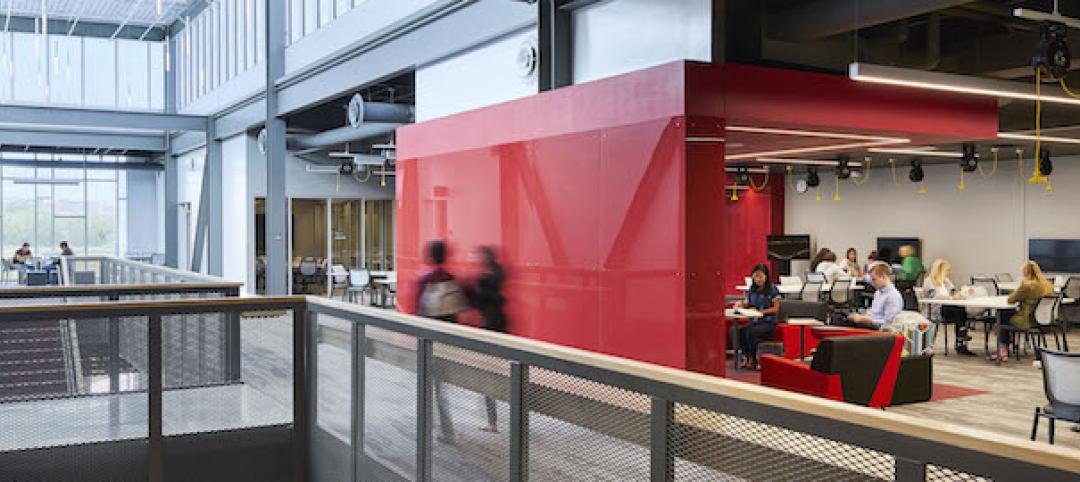With the advent of solid state lighting, often referred to as LEDs, and the digital controls that accompany it, tuning in to a specific “color” of white light is now possible.
In the past, a light source’s color was fixed based on either technology, or a mix of phosphors specific to a bulb, or lamp. Now a single light source can be tuned to output warm white light, cool white light, and anything in between. The output can be fixed for an occupant’s needs, or vary based on time of day or other schedule.
Enter dynamic white lighting. By varying a luminaire’s color temperature, it is possible to mimic daylighting, to some extent, and the natural circadian rhythms that accompany it.
Lighting designers and electrical engineers are now actively working with building owners—predominately schools, retail, healthcare and correctional facilities—to deliver lighting that encourages different behaviors. Tuning the spectrum to cooler light can stimulate a more focused, alert state amongst building occupants, and has been shown to increase productivity.
Conversely, shifting to a warmer spectrum contributes to a calmer, more relaxing environment. In an education environment, cooler lighting can keep students more alert and focused during testing, where warmer light can help younger children calm down after coming in from a rowdy recess. In retail environments the specific blends of color temperatures a couple other design parameters have been shown to attract specific shopper’s personalities.

Lately, a lot of research has been devoted to the effects of light on our circadian rhythms. Our bodies respond in specific ways to light of various correlated color temperatures (CCTs) and underlying spectrums. Cooler white light with a strong blue component can suppress melatonin, and keep you up at night.
However, that same cool blue light can help reset your daily clock if received earlier in the day. When it comes to the built environment, nothing does a better job of delivering the right light at the right time than daylight. However, it’s not always possible for architects to bring in as much natural light as might be desired.
Although the technology has some room for improvement in regards to circadian response, dynamic white lighting can provide some of the benefits of daylighting where natural light is unavailable. In healthcare, dynamic lighting is focused on circadian mimicry to aid healing. Certain therapies and treatments are linked to greater efficacy when applied at certain times of the day, so design is experimenting with natural lighting solutions that mimic the sky outside. This same design approach can be used to limit or treat the symptoms of Seasonal Affective Disorder in locations where weather or latitude may limit sunlight exposure during winter months.
How it’s Done
While LED fixtures and controls technology are available for designing and programming desired CCTs based on the time of day and season, it is not always a simple endeavor. Controls for dynamic white systems come in two technologies: analog and digital. Analog systems are generally better understood by most installers and end users, however, dynamic white lighting requires twice the number of control zones compared to a standard dimming system and are tied to the wiring design requiring an electrician to make changes. With digital systems, dimming and zones are independent of the wiring and can be modified after installation without an electrician, but the control software and system troubleshooting can be more complicated.
Whatever the approach, a dynamic white lighting installation requires close collaboration between the general contractor, electrical contractor, lighting controls manufacturer, architect, engineer, lighting designer, and the building owner. Together, this team must establish how the light system will be designed, installed and controlled based upon the end users’ needs and the technology’s capabilities.
Hesitancies and Limitations
Despite the fact that a number of building owners are pleased with the way dynamic white lighting is boosting alertness and productivity levels in their facilities, many are hesitant to adopt the technology.
For starters, the CCT many people find acceptable is tied to culture and experience. In the states where warmer CCTs have been commonplace, building occupants are not used to or accepting of the appearance of cool white light. The increased complexity of the control systems required to dynamically alter the CCT may not be something facility managers are accustomed with. Furthermore, the increase in complexity and capability are typically tied with added cost for both the products and the installation labor.
In addition, scientists and the lighting community are still working to determine the specific blue light wavelengths and intensities required for stimulating circadian rhythms. And at this point, those levels are only an estimation.
At the same time, some groups have released blue light exposure warnings without covering pertinent information like time of day and hazardous wavelengths. Last year, the American Medical Association released information detailing blue light hazards such as eye damage, impaired sleep, and more. While the article was probably intended to encourage lighting designers to consider the potential hazards of lighting design, the lack of detail likely provided confusion and general distaste to the public.
What’s to Come
Although technical limitations currently exist, it won’t be long before lighting manufacturers can tune the spectrum to achieve desired circadian benefits with a variety of fixtures from which to choose. And as researchers work to define the specific blue light levels of natural circadian rhythms, it is anticipated that LED lighting technology will be able to more accurately simulate the desired biological response. Aside from the potential circadian benefits, there are plenty of other known benefits of dynamic white lighting.
As for the controls systems, easier to use and more simplified user interfaces with greater automation are emerging, making the whole dynamic lighting process less daunting and more accessible.
About the Author
Sean Avery, PE, LEED AP, is a Senior Associate with DLR Group. His electrical engineering experience spans power, controls, and lighting. In recent years, he's grown his specific passions for lighting design and high-performance building design, with emphasis in on-site renewable power generation. Avery continues to explore more energy-effective approaches to powering and lighting facilities. He is expert in early modeling and analysis (daylighting, climate, thermal performance, etc.) to inform the development of effective passive design strategies, followed by the design of energy-efficient systems to ensure user comfort, wellbeing, and effectiveness.
More from Author
DLR Group | Jan 8, 2024
DLR Group adds executive leaders
DLR Group Chief Executive Officer Steven McKay, AIA, RIBA, announced new executive leaders for the 100% employee-owned, globally integrated design firm.
DLR Group | Nov 30, 2023
A lasting housing impact: Gen-Z redefines multifamily living
Nathan Casteel, Design Leader, DLR Group, details what sets an apartment community apart for younger generations.
DLR Group | Nov 6, 2023
DLR Group opens office in Nashville, Tenn.
DLR Group is expanding its presence in the Southeast with the opening of an office in downtown Nashville, Tenn.—a collaborative effort led by DLR Group Principals Matthew Gulsvig, AIA, LEED AP, and Randall Coy.
DLR Group | Jan 27, 2021
Selecting indoor air quality monitors to maintain healthy spaces
In searching for an indoor air quality monitor, most devices will measure a combination of temperature, relative humidity, carbon dioxide, particulate matter, and total volatile organic compounds.
DLR Group | Sep 1, 2020
The rise of inquiry-based learning in K-12 communities
Inquiry-based education offers a methodology that does not rely solely on the educator being the lead in all learning.
DLR Group | Aug 31, 2020
Reopening campus performance arts centers
Live productions, which offer students the opportunity to hone their skills with true audience feedback, currently pose health risks for students and faculty.
DLR Group | Jun 11, 2019
The power and possibility of adaptive reuse
Building reuse generally offers greater environmental savings than demolition or new construction.
DLR Group | Apr 29, 2019
A look ahead to learning in 2050
Fast forward to the year 2050 and beyond, and imagine what education looks like.
DLR Group | Aug 31, 2018
The building data analytics revolution in three acts
Increased transparency of operational building data is impacting accountability.
DLR Group | Jul 2, 2018
Data, Dynamo, and design iteration
We’re well into the digital era of architecture which favors processes that have a better innovation cycle.
















